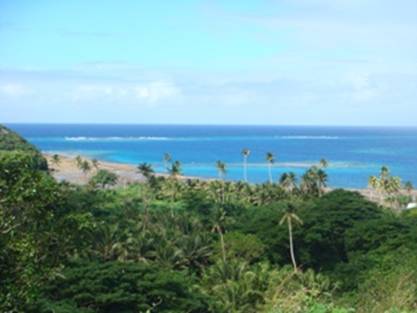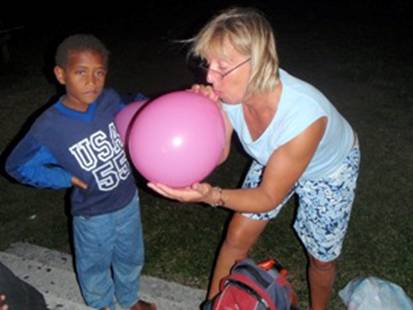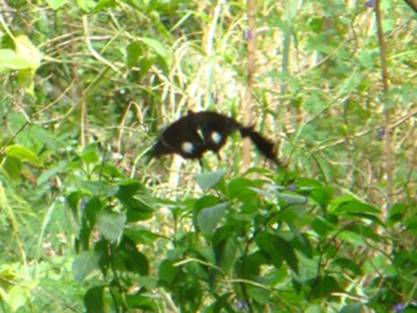Makongai, Fiji. 17:26:49S 178:51:12E

|
We departed from Savusavu at 0720 on the 3rd July,
bound for the Now this blog entry was intended to cover Makongai, Nananu
and around the northern reef passage to Musket Cove. BUT, I have completely
failed to be ruthless in my picture editing on Makongai….because it truly
is a very special place and so it needs doing JUSTICE!! I am then going to squander
more of the kids inheritance on pictures and at the same time extol the virtues
of this fascinating Firstly some background. The island is protected by a
barrier reef that is difficult to enter, and without Curley’s waypoints I
doubt if we would have had the courage to proceed through the tortuous channels
that go through the reef and into the bay. Either way you need settled weather
to attempt entry. Once in the main anchorage, it is very well protected
on three sides. The holding is good in mud and sand, but there are coral heads
and coral patches, so it is a must that you use 100% chain, and with a snubber.
The principle activity of the local folks in this bay is the cultivation of
Giant Clams, so there are restricted areas in the bay. This does lead to some
interesting snorkelling opportunities, especially on the coral heads. The island is a former Leper Colony. This opened in 1911,
and serviced not only The views around the
There are now a total of 85 souls living on Makongai. Mostly
in the two villages. The main village has a population of 25 people and there
is a very active community here with families, and plenty of children. Their
Chief goes by the name of Watson.
A couple of our rally boats had arrived the previous day,
and had gone immediately to see Watson and to offer him the traditional gift of
Cava. This had been accepted and the crews welcomed to the Anyhow, I am starting to ramble so must get on! After “check
in” as it were, we all went off to do our own things, before preparing
food for the BarBQ. There were several BarBQ’s brought ashore and LOADS
of food. Including a large Mahi Mahi that had been caught that very afternoon
by Anahi. The site of the BarBQ was directly outside the village hall, and as
soon as it got dark they very kindly placed a couple of fluorescent lights out
of the hall, on long leads, all running off their limited electricity supplies.
So naturally, many members of the village community joined us and shared our
food and in some cases wine and beer.
Dorothy from
This enthusiasm by the Whilst we were taking the food and drink on the old steps,
the local band came out to entertain us with traditional Fijian songs and music
by guitar and drums. Once the food was gone we were invited to join Watson and
his community in a Cava evening with local music, in the village hall. We all
sat cross legged on the rush mats, listening to the music, taking the Cava,
whilst the elder village children beat the Cava roots in a giant motar outside,
and prepared the next bowl of Cava for the evenings refreshments.
I gather most of the villagers leave their homes each
evening to participate in these gatherings, as this is the only part of the
village that is allowed lighting in the evenings after 7pm, due to the limited
diesel supplies they have to run the generator. The sense of community and the haunting music made for a
very special and memorable evening. At 2045, Watson in what can only be described
as a charming way, dismissed us for the night. It is lights out at 2100 hours
and he wanted some time with his people. Just as well and the last batch of
Cava that was served was much stronger than the earlier “brew” and
my lips were definitely starting to tingle. We had also learned during the course of the evening that
the village had suffered something of a tragedy the previous week. There local ferry
boat, had capsized whilst coming through the reef in bad weather. It had tipped
out their new diesel supplies for the generator. Much worse, the people on
board spent some 4 hours in the water, before being rescued. Sadly, an infant
of six months died during that time and the funeral was to be the following
day. This also meant that they were low on diesel supplies. So all the rally
boats volunteered to give them at least 20 litres per boat ,to help them
through until the next supply boat arrives in two weeks time. That night we had a most spectacular thunderstorm and I was
very glad we had 75m of chain down with the anchor. Torrential rain, driving
gusts of up to 40 knots and scintillating lightening………so I
am told. I slept through it all. Perhaps Cava should be sold as a sleeping
draught? The following morning we decided to set of for the trek across
the
This was a great reminder that nature came first. In just 40
years the jungle had taken back most of the formers colony. Some of the Banyan Trees in the jungle were huge with spectacular
dangling root systems
But the real gem of the jungle was the wild life. Birds
galore, Friuit Bats……………….. Loads and loads of Frogs and Toads.
Some of these guys were a good 9 inches wide or more. Those
pincers would have your finger off in a jiffy. I tried one out on a half inch
diameter stick and it snapped thru easy as a hot knife thru butter. Dashing around the fallen leaves were dozens of small Lizards
with electric blue tails………
But the best of the best were the Butterflies. Hundreds of
them, and several species. Some just tiny, with a wing span of only half and
inch or so, with bright orange wings. Right up to the large black butterflies,
with a pair of big white spots on the lower wings, just darting about in
the shafts of sunlight pouring thru the tree canopy. Jennie and I rattled
of dozens and more pictures with our cameras. We mush have looked like a couple
of Ballet dancers who had overdosed on Cava. Spinning here and there, in
a rhythmic dance to follow the butterflies, in a vain attempt to capture the
moment for posterity. Alas this was our best effort…………………
Given the wing span of this creature was IRO 4 to 5 inches,
this was a truly pitiful effort at wildlife photography! After just under 2 hours we came upon the second village. This
had an air of decay about it, with very run down shacks with tomatoes and the
like being grown in the gardens. The island school was the oasis of the
village. It was immaculate, with manicured grounds and the kids were
colourfully dressed in pristine uniforms. They whooped and shouted a welcome “Bula,
Bula” to us. But as lessons were in progress we retreated to the beach or
a rest before the trek back across the other side of Makongai. By the time we got back to the boat we were, not surprisingly,
knackered! So we had a quite night in before the next leg the following
morning. |








